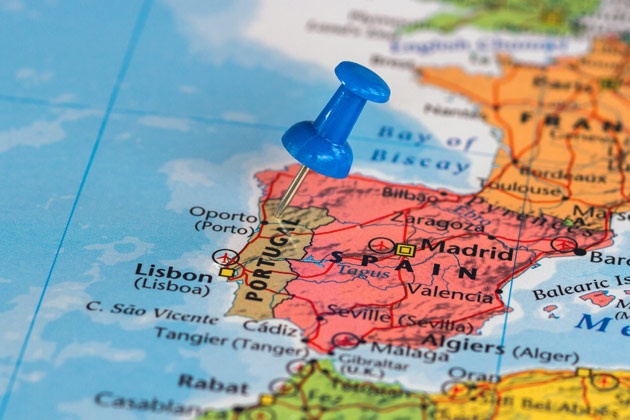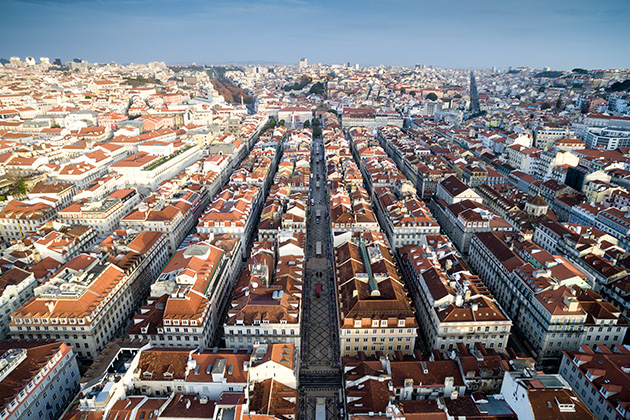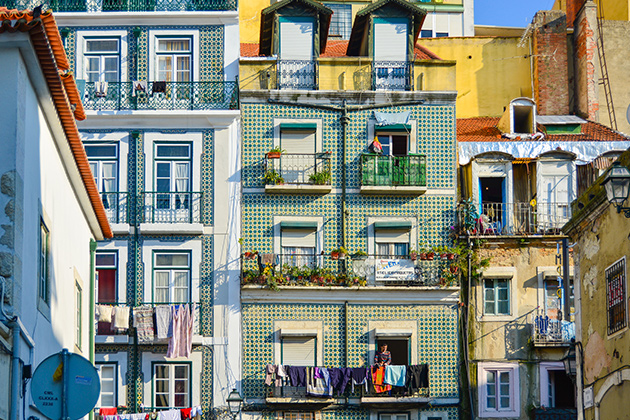
Lisbon’s neighbourhoods tell a story that has crossed civilisations and provide an example of multiculturalism reflected in the landscape, the architecture and the people. Here are five of the main examples.
Alfama
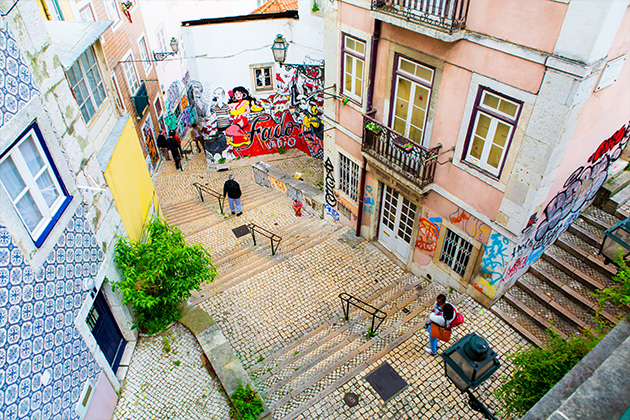
The Alfama neighbourhood is one of the city’s landmarks. With its labyrinthine houses and narrow streets that empty into alleys, stairways and patios, it spreads from the walls of the São Jorge castle down to the Tagus River.
The Santa Luzia Belvedere is one of the places where you can get a good view over the neighbourhood, including the National Pantheon, the Santo Estêvão Church and the towers of the São Miguel Church.
The square outside of the latter, São Miguel Square, is one of the epicentres of the Popular Festivals of Lisbon, and fills up every year with music, dancing and the smell of grilled sardines, especially on the evening of 12 to 13 of June, the municipal holiday in honour of Saint Anthony.
Besides the Catholic churches, Alfama also boasts heritage of the Muslim civilisation dating back to 711. This is clear in the very name: Alfama derives from the “al-hammâ”, which means “warm water spring” and alludes to the several springs that exist in the vicinity.
Another sign is in the layout of the houses, which reminds one of urban landscapes in North Africa. The neighbourhood was completely destroyed by the great earthquake of 1755 but rebuilt according the original style.
The Cerca Moura, or Cerca Velha, made up of the remnants of the defensive structure, also bears witness to the Centuries of Arab presence in the city.
Amidst the houses of the simple folk there are also some examples of noble residences, such as the Chafariz d’El Rey Palace, the Belmonte Palace or the Casa dos Bicos which now houses the José Saramago Foundation, Portugal’s Nobel Prize in Literature.
And Alfama is, of course, also the fado neighbourhood. Besides the Fado Museum, where you can learn all about this famous Portuguese style of singing, there are a number of restaurants and fado houses that host regular shows, such as the Parreirinha de Alfama or the bars in Rua dos Remédios, where you can go for a late night out.
Bairro Alto
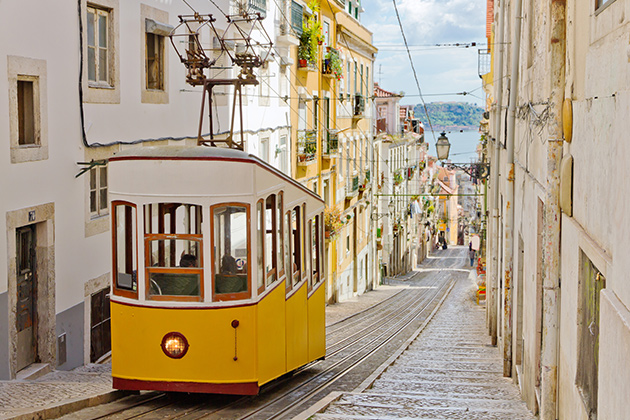
This neighbourhood has been home to fishermen, Jesuits and members of the bourgeoisie. It was a Bohemian centre in the 80s becoming home to art galleries and newspapers and is still one of the places you must visit in Lisbon, whether to go out at night, have dinner or just stroll.
The area began to be built up in the XV Century, according to a methodical scheme of buildings with little balconies, providing a backdrop of verandas used to hang out washing that can still be seen in different parts of Lisbon.
It benefited from the fact that it survived the Lisbon earthquake of 1755 almost unscathed, leading to the opening of taverns and bordellos and gaining a shady reputation that in the past century attracted artists and intellectuals.
The cultural and nightlife side of it remains popular today and some classics remain active since the 80s, such as the historic Pap’Açorda or popular bar Frágil, founded in 1982 on the site of an old bakery.
In 1994, with Lisbon named European Culture Capital, the Bairro Alto gained some new haunts, such as the Zé dos Bois Gallery, one of the most important cultural centres in the city.
The neighbourhood’s great charm lies precisely in the mix of local population, fashionistas and nightlife. And just outside of the Lisbon neighbourhood itself you can get one of the best views of Lisbon from the São Pedro de Alcântara Belvedere, visit the Bourgeoise Príncipe Real or the Bica sector.
Baixa
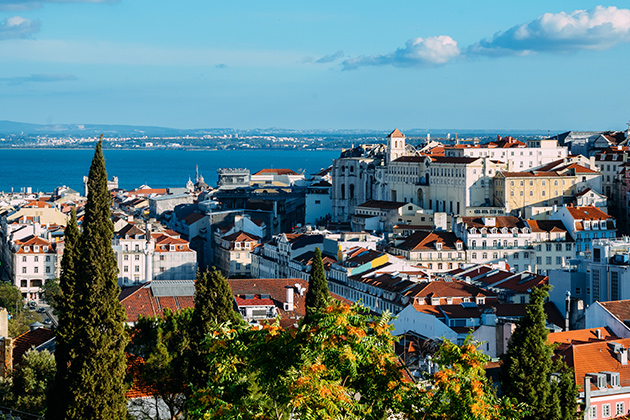
This is Lisbon’s downtown district. Located by the river, it is a commercial hub, marked by the style of the Marquês de Pombal period, with streets that lead straight down to the Tagus.
The Baixa district is an important part of the city’s geography. Also known as the Baixa Pombalina, due to the fact that Pombal designed it following the great earthquake of 1755, it is easily identifiable by its octagonal layout.
As you walk along the traditional Portuguese cobblestones of this Lisbon neighbourhood, to the sound of the tram, you might lose sight of the fact that you are in the administrative capital of Lisbon. This is where you will find structures such as City Hall or the Ministry of Finance, which forms one of the sides of the Praça do Comércio, or Terreiro do Paço, a Lisbon landmark.
From this magnificent square you can walk right along the river, following along the Ribeira das Naus and the Cais das Colunas. Nowadays these are great spots just to sit back and enjoy the city and its view over the two bridges across the Tagus, but it used to be a bustling centre of activity with hundreds of ships arriving from the discoveries or from the trade routes, carrying Chinese porcelain or Indian spices.
You can still see activity on the waters, but its most likely the ferries that cross the river. This was also the stage for some important historical events, such as 1908 regicide that killed King D. Carlos I and his eldest son Luís Filipe, that hastened the fall of the Monarchy and the imposition of a Republic, two years later.
As you leave the Terreiro do Paço, with your back to the river, go along the Rua Augusta, a pedestrian high street that will lead you to another of the city’s main squares, the Rossio, formally D. Pedro IV Square, flanked by the D. Maria II National Theatre, to the north and the Santa Justa Elevator and the Carmo Convent ruins to the southeast.
The Largo do Carmo, just outside the convent, was where the deciding moments of the 25 April revolution in 1974 played out, freeing Portugal from 40 years of dictatorship, as then leader Marcello Caetano surrendered and abandoned the Carmo barracks.
Mouraria
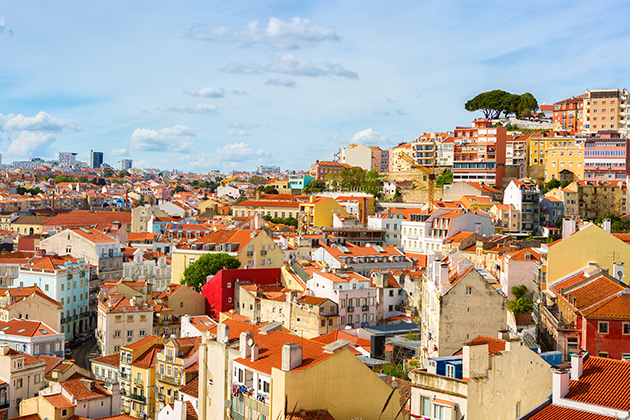
From agricultural land to Moorish quarter, after the Christian conquest, the Mouraria has gone through galloping transformation. Today it maintains its sinuous and mysterious layout.
This is one of Lisbon’s most multicultural neighbourhoods, with African and Asian restaurants, small shops and a frantic pace. Rua do Benformoso, a street that leads to the neighbouring Intendente sector, is a good example of this.
But the history of this small and fertile valley in within the city, that used to be cultivated with vineyards and fields that supplied the São Jorge Castle, is mostly concentrated in its name, that alludes to the Moors who, following the conquest of Lisbon by the first king of Portugal, D. Afonso Henriques, in 1147 (the city had been dominated by the Moors as of the VIII Century), found refuge in this part of the city over the centuries.
This was, so to speak, the Muslim commune of Lisbon, amongst the narrow buildings and the spindling roads. And it was precisely during the occupation of the city by the Christians that Martim Moniz gave his life, using his body to keep the Muslims from closing one of the city’s gates so that his comrades could get in. Today one of the main squares in the city bears his name.
A leap through history brings us to another important period in the life of the Mouraria – the expansion of fado music. Following the year of the earthquake of 1755, a difficult time for the city, the Mouraria would become a popular neighbourhood and it was in this atmosphere that Maria Severa arose. A fado singer, a smoker (a rarity among women in those days) and a prostitute.
Half mystery, half myth, she is still considered one of the creators of fado. The sculpture of a traditional fado guitar in the entrance to the Rua do Capelão pays tribute to this.
Over 200 years later the area has not lost its rhythm, multiculturalism or commercial activity. There is no shortage of small taverns and cultural life in the Mouraria. Nor of beauty. It is worth taking a walk around the neighbourhood, up the steep Escadinhas de São Cristóvão and then along the Rua das Farinhas to the Largo da Rosa.
A little further north another building stands out, celebrated for its tiles: the Colégio dos Meninos Órfãos was founded in 1273 in the Rua da Mouraria, to take in destitute children.
São Vicente
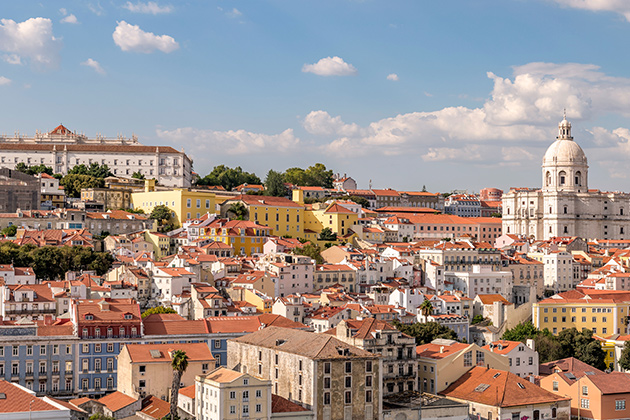
In the São Vicente neighbourhood you can find the centennial Feira da Ladra flea-market and also one of the architectural landmarks that took longest to build, the National Pantheon.
Surrounded by the Graça, Castelo and Alfama neighbourhoods, São Vicente is located on the hillside that rises from the Santa Apolónia train station – witness to waves of emigrants who left the misery of Portugal in the 60s and 70s – and commands panoramic views over the Tagus.
As you make your way up the steep hills you begin to see the Pantheon, a baroque building that took a painful 400 years to be completed. At the time it was the Church of Santa Engrácia, which led the term “obras de Santa Engrácia” to become synonymous with apparently endless construction projects.
Today it is the burial place of important figures in Portuguese history and culture, such as the recent cases of fado singer Amália Rodrigues and footballing legend Eusébio.
Right next to the Pantheon is the Campo de Santa Clara, where the Feira da Ladra takes place every Tuesday and Saturday, without fail. This is Lisbon’s oldest and most peculiar flea-market.
It is known for the sale of old items and second-hand objects and has existed since the XII Century, although not always in the same neighbourhood in Lisbon. It finally settled in São Vicente in the XIX Century, between the Campo de Santa Clara, with its garden overlooking the river, and the São Vicente de Fora Monastery, another local landmark.
Known as one of the finest examples of Portuguese mannerism, this church, which is also a museum, boasts a large collection of Baroque tiles, including the impressive Fables Gallery.
